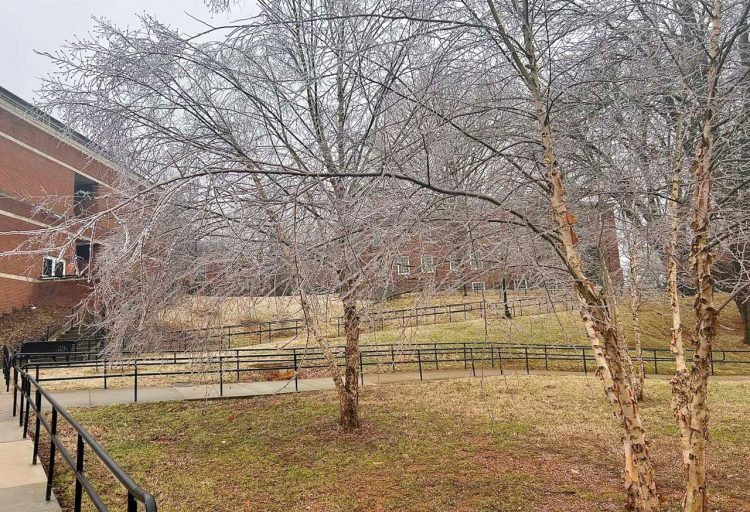Folks in the Art and Design Building see a lot of great expression in dozens of mediums, but when the name Khari Turner is uttered, there is a change in the tone. It has the feel of one part rock star and another part preacher, emanating a vibe of anticipation and awe.
Turner’s senior project, named “Behind Bars Beyond Borders,” opened in the second-floor gallery of the Art and Design Building Monday evening, April 15, with some home-cooked macaroni and cheese and meatballs and nearly a hundred anxious people who wanted to be with the artist.
Turner opened the exhibit by spending a solid half hour walking his audience through the dozen pieces and telling them how it all started.
Turner explained, “After my first show, my teacher was looking at one of my pieces and asked me who this person was.”
Until that question, Turner reflected, he was taking the depth of his work for granted.

Khari Turner next to his display called “The Wall” on Monday, April 15. This piece is on display in the Art and Design Building’s Living Gallery until April 22. SEAN SIPLE | THE ALL STATE
The first piece near the entrance of the Living Gallery is composed of nearly 30 feet of braided steel wire that is four inches in girth, slung down from the open joists and held to the floor by two fine work boots filled with hardened concrete. The artist said it was a reminder of Martin Luther King’s admonition: “It is cruel jest to say to a bootless man that he ought to lift himself by his own bootstraps.”
While standing in front of “Protest and Hate Life Over Law,” the largest piece in the show, Kiwana Bridges, a junior majoring in communication said, “It’s kind of hard for me to figure [art] stuff out, but this one had a lot going on so I had a lot of spots to look at. This is meaningful and powerful.”

Khari Turner’s piece titled “Separate but Equal” is on display in the Art and Design Building’s Living Gallery until April 22. SEAN SIPLE | THE ALL STATE
She continued, “This is the most powerful part of it that I liked because I think every black person remembers the Trayvon Martin story… with the Skittles across his mouth… the Emancipation Proclamation behind it… the protest … in the beginning, it starts out black and white … it moves into this color… it is ironic that nowhere in it does it get any better, nowhere in it is there a happy ending.”
“African American and Hispanic people make up 29% of the population. We make up 58% of the incarceration in the United States.” Turner said. “This show was my way of thinking about prison reform.”
Talking through his thought-provoking black toilet perched on top of the white toilet named “Separate but Equal,” Turner said, “If it is separate, but one is above the other, is it equal?”
He took some time to demonstrate the continuity of materials he used in a handful of pieces that used wrapping paper that represented Confederate monuments in Stone Mountain, Blue Lives Matter and the Emancipation Proclamation. Turner offered “It allowed me to put a meaning within a meaning.”

Khari Turner’s oil painting titled “No Escape with Hard Time.” This piece is on display in the Art and Design Building’s Living Gallery until April 22. SEAN SIPLE | THE ALL STATE
Two large colorful abstracts make a respectful inspiration from Pablo Picasso’s “Guernica.” “No Escape With Hard Time” is Turner’s complex hell representing the United States prison industrial complex. “Treat Us Like Humans” deals with his view of the separation of families at the US southern border.
The portion of the exhibit reflecting on the current southern border crisis was dominated with a chain link fence with pacifiers and little children’s gloves hanging on it.
“Each one of these items represent 10 kids who are lost, or missing or separated from their parents. There are 1,500 of those children,” Turner said.
The show closes with a self-portrait of the artist, made mostly from discarded oil paint left over from creating other pieces in the show. His face is outlined by pages from Harper Lee’s “To Kill a Mockingbird.” Pages of the book stack over the other pages.
Turner said this method is representative of “never allowing us to have the full story.”
The self-portrait is entitled “On any day I could be Tom,” referring to Lee’s Tom Robinson, the defendant who was found guilty, Turner said, “because it comes down to the skin tone.” Tom gets lynched in Lee’s story.
Khari Turner graduates from APSU this semester. He is on his way to the Columbia School of the Arts in New York City as a Master’s candidate. “Behind Bars, Beyond Borders” was on display in the Living Gallery on the second floor of Art and Design until April 22.

Khari Turner’s “Protest and Hate Life Over Law” mixed media piece. This piece is on display in the Art and Design Building’s Living Gallery until April 22. SEAN SIPLE | THE ALL STATE



